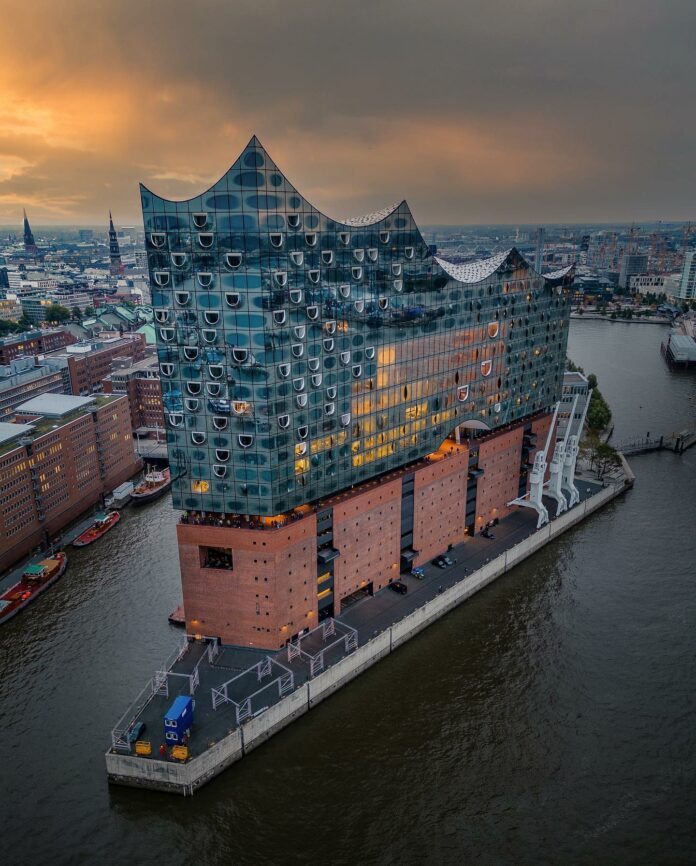The Elbphilharmonie, a striking landmark in Hamburg, Germany, is a testament to modern architectural innovation and acoustic engineering. Situated in the HafenCity district along the Elbe River, this iconic concert hall combines historic elements with cutting-edge design, redefining the cultural landscape of the city. In this article, we explore the history, construction, and features of the Elbphilharmonie, delving into its architectural significance and its impact on Hamburg’s skyline.
History of the Elbphilharmonie

Construction of the Elbphilharmonie began on April 2, 2007, on the site of the old Kaispeicher A warehouse. Originally slated for completion in 2010, the project faced multiple delays and budget overruns. By November 2008, the estimated cost had risen to 450 million euros, and by August 2012, it had surpassed 500 million euros due to additional expenses for a more robust roof. The construction was officially completed on October 31, 2016, with the final cost reaching 789 million euros. The grand opening was celebrated on January 11, 2017, with a test concert held on November 25, 2016.
The building’s eastern section houses the Westin Hamburg hotel, which opened in November 2016, while the western portion includes 45 luxury apartments.
Construction and Design

Designed by the Swiss architectural firm Herzog & de Meuron, the Elbphilharmonie features a glass structure with a distinctive curved roof, often referred to as the “glass wave.” This modern addition sits atop the existing red-brick Kaispeicher A, which dates back to 1966. The design aimed to create a unique silhouette against Hamburg’s skyline.
Contrary to initial plans, the interior of the old warehouse was completely dismantled, retaining only the protected facade and some foundations. The new structure is supported by 428 springs, which rest on 1,745 piles driven deep into the Elbe Riverbed. The facade comprises 2,200 glass elements, each consisting of four panels, coated with a layer to regulate light and temperature. The architects intended the undulating glass surface to resemble a massive crystal reflecting the ever-changing sky, water, and cityscape.

The building rises 110 meters (360 feet) and is surrounded from the ground floor to the Plaza on the eighth floor by the Kaispeicher A facade. This makes it the tallest inhabited building in Hamburg, surpassing the Radisson hotel by a few meters. With a total area of approximately 120,000 square meters, it houses three concert halls and extensive backstage areas.
Interior Features

The Elbphilharmonie’s concert hall is renowned for its superior acoustics, a result of meticulous design by the architectural office “One to One” in Frankfurt, led by Benjamin Samuel Koren. The hall features a central stage surrounded by seating on multiple tiers, with the highest seats positioned 17 meters from the stage. Each audience member is no more than 30 meters from the conductor.
The hall’s acoustic quality was fine-tuned using advanced computer simulations by Yasuhisa Toyota, a renowned Japanese acoustician. To achieve optimal sound, the walls and ceiling are covered with 10,000 custom-shaped gypsum panels, designed to minimize echo and ensure clear, distinct sound. These panels, weighing between 70-80 kilograms each, are mounted on a metal framework and vary in thickness from 35 to 200 millimeters, with some weighing up to 150 kilograms per square meter. The gypsum panels were crafted and installed by Peuckert in Mehring, east of Munich.
The Plaza

At a height of 37 meters, the Plaza serves as a public space accessible to visitors. It functions as a lobby for the concert hall, hotel, and apartments, and features an outdoor terrace offering panoramic views of the Elbe River, the port, and Hamburg’s city center. The Plaza floor is paved with thousands of red bricks, matching the historic warehouse’s aesthetic. A special kiln was used to produce these bricks, ensuring they closely resemble the original warehouse materials.
Before the official opening in December 2016, the Plaza attracted up to 16,000 visitors daily.
Conclusion
The Elbphilharmonie stands as a remarkable fusion of historical preservation and contemporary architecture. Its innovative design, coupled with advanced acoustic engineering, makes it one of the world’s premier concert halls. As Hamburg’s tallest inhabited building and a symbol of modern cultural excellence, the Elbphilharmonie continues to captivate visitors with its stunning architecture and world-class performances.
